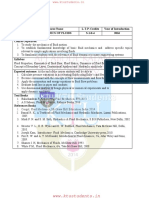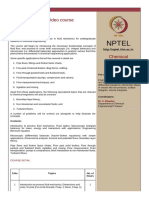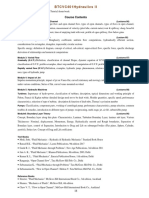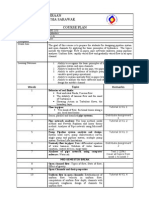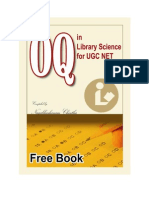CV 303 Hydraulic Engineering - I: Course Contents
CV 303 Hydraulic Engineering - I: Course Contents
Uploaded by
Sushant WaghmareCopyright:
Available Formats
CV 303 Hydraulic Engineering - I: Course Contents
CV 303 Hydraulic Engineering - I: Course Contents
Uploaded by
Sushant WaghmareOriginal Description:
Original Title
Copyright
Available Formats
Share this document
Did you find this document useful?
Is this content inappropriate?
Copyright:
Available Formats
CV 303 Hydraulic Engineering - I: Course Contents
CV 303 Hydraulic Engineering - I: Course Contents
Uploaded by
Sushant WaghmareCopyright:
Available Formats
CV 303 Hydraulic Engineering – I
Teaching Scheme: (3 Lectures + 1 Tutorial) hours / Week
Pre Requisites: Engineering Mechanics (EM02)
Course Outcomes: On completion of the course, the students will be able to:
CO1: Calibrate the various flow measuring devices.
CO2: Determine the properties of fluid and pressure and their measurement.
CO3: Understand fundamentals of pipe flow, losses in pipe and analysis of pipe network.
CO4: Visualize fluid flow phenomena observed in Civil Engineering systems.
Course Contents
Module 1: Fundamental Concepts (6 Lectures)
Definition of fluids, fluid properties-density, specific weight, specific volume, specific
gravity, viscosity, compressibility, surface tension, capillarity, vapour pressure, types of
fluids - Newtonian and non-Newtonian fluid, continuum, fluid pressure
Module 2: Fluid Statics (6 Lectures)
Forces on fluid elements, fundamental equation, manometers, hydrostatic thrust on
submerged surfaces, buoyancy, stability of unconstrained bodies, fluids in rigid body motion
Module 3: Fluid Kinematics (6 Lectures)
Types of flow, continuity equation, derivation and applications of momentum equation,
Euler's equation, Bernoulli's equation, velocity potential and stream function, concept of flow
net
Module 4: Laminar Flow (9 Lectures)
Fully developed laminar flow between infinite parallel plates, both plates stationary, upper
plate moving with constant speed, fully developed laminar flow in pipe.
Turbulent flow: Shear stress distribution and turbulent velocity profiles in fully developed
pipe flow, velocity distribution and shear stresses in turbulent flow, Prandtl mixing length
theory, Nikuradse experiment, Introduction to Boundary Layer Theory
Module 5: Dimensional Analysis and Similitude (5 Lectures)
Nature of dimensional analysis, Rayleigh’s Method, Buckingham pi theorem, dimensionless
groups and their physical significance, flow similarity and model studies, Scale Effects,
Distorted and Undistorted Models.
Module 6: Flow Measurement (7 Lectures)
Direct methods, restriction flow meters, linear flow meters, traversing methods,
measurements in open channel flow
Flow through Pipes: Loss of energy in pipes, pipe discharging from a reservoir, pipe
connecting two reservoirs in series and parallel, siphon, transmission of power through
nozzle, water hammer in pipes- rigid and elastic water column theory, surge tanks - function,
calculation of head loss, introduction to Moody's chart, nomograms and other pipe diagrams
Text Books
Fox. R. W. and Mc-Donald. A. T., “Introduction to Fluid Mechanics”, John Wiley
and Sons, Fifth Edition
Modi and Seth, “Fluid Mechanics and Hydraulic Machinery”, Standard Book House,
Tenth Edition , 1991
Kumar K. L., “Fluid Mechanics”
Bansal R. K., “Fluid Mechanics”
Reference Books
Streeter V. L., Bedford K. W. and Wylie E. B., “Fluid Dynamics”, New York,
McGraw-Hill, Ninth Edition, 1998
Som S. K. & Biswas G., “Introduction to Fluid Mechanics & Fluid Machines”, Tata
McGraw-Hill, 2nd Edi., 2003
You might also like
- HSE 03 Kitchen Inspection ChecklistDocument3 pagesHSE 03 Kitchen Inspection ChecklistApirinmu100% (10)
- Kamisama Kiss v07Document194 pagesKamisama Kiss v07JSA2343100% (1)
- WP Integrating Active Directory MLDocument14 pagesWP Integrating Active Directory MLFarid BouNo ratings yet
- Fluid MechanicsDocument3 pagesFluid MechanicsVipin KallingalNo ratings yet
- S. Y. B. Tech. (Civil Engineering) - I, Semester-III: Course ContentDocument5 pagesS. Y. B. Tech. (Civil Engineering) - I, Semester-III: Course ContentashoknrNo ratings yet
- 4me3 Fluid MechanicsDocument4 pages4me3 Fluid MechanicsGautam GunjanNo ratings yet
- Fluid MechanicsDocument3 pagesFluid MechanicskennypennyNo ratings yet
- ME212 Fluid MechanicsDocument2 pagesME212 Fluid Mechanicsnandan144No ratings yet
- Fluid MechanicsDocument3 pagesFluid MechanicsRyan MichaelNo ratings yet
- 2CE01Document2 pages2CE01darshantalpda07080901No ratings yet
- CivilsyllDocument32 pagesCivilsyllShrinidhi KulkarniNo ratings yet
- CivilsyllDocument131 pagesCivilsyllYashwanth YashuNo ratings yet
- PDFDocument4 pagesPDFPradeep KumarNo ratings yet
- Fluid Mechanics SyllabusDocument2 pagesFluid Mechanics Syllabusshailendra_236No ratings yet
- Fluid MechanicsDocument2 pagesFluid Mechanicsap5208780No ratings yet
- Course Folder (Fluid Mechanics - II)Document3 pagesCourse Folder (Fluid Mechanics - II)fawad naeemNo ratings yet
- ME 203 Mechanics of FluidsDocument3 pagesME 203 Mechanics of FluidsSherwinNo ratings yet
- Lecture Plan Instructor K S RajmohanDocument4 pagesLecture Plan Instructor K S RajmohanSwapnil TripathiNo ratings yet
- PDFDocument3 pagesPDFMonu singhNo ratings yet
- Syllabus of Fluid MechanicsDocument2 pagesSyllabus of Fluid MechanicsRavindra ShettyNo ratings yet
- SYLLABUSDocument3 pagesSYLLABUSInzamam Ul HaqueNo ratings yet
- Civilsyll PDFDocument31 pagesCivilsyll PDFmohanNo ratings yet
- Ce603 Fm-IiDocument1 pageCe603 Fm-IiTarang ShethNo ratings yet
- Mechanics of FluidsDocument3 pagesMechanics of Fluidseldhopaul19894886No ratings yet
- Ce8302 Fluid Mechanics CivilDocument2 pagesCe8302 Fluid Mechanics CivilersnkrishnanNo ratings yet
- FMM Syllabus Revised (2014-15)Document4 pagesFMM Syllabus Revised (2014-15)avcschaudhariNo ratings yet
- SCIV013Document2 pagesSCIV013Krishan Kumar SharmaNo ratings yet
- MI 205 Luid Mechanics: B. K. GandhiDocument6 pagesMI 205 Luid Mechanics: B. K. GandhiAshutosh SinghNo ratings yet
- Syllabus of Hydraulic Engineering Section CE-213 Fluid Mechanics Course Category: DC L - T - P: 3 - 1-0 Credit: 4Document35 pagesSyllabus of Hydraulic Engineering Section CE-213 Fluid Mechanics Course Category: DC L - T - P: 3 - 1-0 Credit: 4subxaanalahNo ratings yet
- Me206: Fluid Mechanics CREDITS 6 (L 4, T 0, P 2)Document3 pagesMe206: Fluid Mechanics CREDITS 6 (L 4, T 0, P 2)vipshw8702No ratings yet
- syllabus fmDocument3 pagessyllabus fmSRIT MENo ratings yet
- NIT Meghalaya Prerequisites For Fluid MechanicsDocument2 pagesNIT Meghalaya Prerequisites For Fluid MechanicsManish SahuNo ratings yet
- APL 106: Fluid Mechanics (3-1-0) Lecture Time: 11 Am-12 PM, T TH F Slot-F (LH 310) Tutorial Time: TBDDocument3 pagesAPL 106: Fluid Mechanics (3-1-0) Lecture Time: 11 Am-12 PM, T TH F Slot-F (LH 310) Tutorial Time: TBDakanksh sandeepsaxenaNo ratings yet
- 5 Third Year First SemesterDocument7 pages5 Third Year First SemesterRojan PradhanNo ratings yet
- Core Course 1: Fluid Dynamics 1: Appendix I: Core CoursesDocument14 pagesCore Course 1: Fluid Dynamics 1: Appendix I: Core CoursesDaniel MoraNo ratings yet
- Pdfjoiner PDFDocument11 pagesPdfjoiner PDFPratik Sarkar RebornNo ratings yet
- 4th Sem DbatuDocument5 pages4th Sem DbatuMukesh BhelwaNo ratings yet
- ME 219: Fluid Mechanics, Autumn 2017: SyllabusDocument1 pageME 219: Fluid Mechanics, Autumn 2017: SyllabusRoshan NayakNo ratings yet
- Semester IiiDocument178 pagesSemester IiiAkshil ShahNo ratings yet
- CIVIL Fluid Mechanics SyllabusDocument2 pagesCIVIL Fluid Mechanics Syllabusdurga sharmaNo ratings yet
- Se Ce SyllabusDocument23 pagesSe Ce SyllabusPrashant PatilNo ratings yet
- SyllabusDocument2 pagesSyllabusGoutam VarmaNo ratings yet
- Fakulti Kejuruteraan Universiti Malaysia Sarawak SESI 2-2008/2009 Course PlanDocument3 pagesFakulti Kejuruteraan Universiti Malaysia Sarawak SESI 2-2008/2009 Course PlanOng George SammyNo ratings yet
- Fluid MechanicsDocument2 pagesFluid MechanicsJosiah AdesolaNo ratings yet
- SyllabusDocument58 pagesSyllabusHariharanNo ratings yet
- CHT 203 PDFDocument1 pageCHT 203 PDFAryan KhanNo ratings yet
- Mechanics of Fluid (UCE03B03) Total Credit: 03 Contact Periods: 03 (2L+1T+0P)Document5 pagesMechanics of Fluid (UCE03B03) Total Credit: 03 Contact Periods: 03 (2L+1T+0P)David HumphreyNo ratings yet
- Revised Civil Engineering Syllabus For Direct Second Year 2020 21 Sem IIIDocument6 pagesRevised Civil Engineering Syllabus For Direct Second Year 2020 21 Sem IIIvebogaming03No ratings yet
- Fluid MechanicsDocument2 pagesFluid Mechanicsshekhadaa100% (1)
- Fluid MechanicsDocument2 pagesFluid MechanicsRAMAN TYAGINo ratings yet
- ME301 Fluid Mechanics I Syllabus (2022)Document2 pagesME301 Fluid Mechanics I Syllabus (2022)luciatricasarbesuNo ratings yet
- CE3301 FLUID MECHANICS SyllabusDocument1 pageCE3301 FLUID MECHANICS SyllabusBaskar Singh GNo ratings yet
- Syllabus of B. Tech. in Mechanical Engineering Semester III Cs 1312:numerical Analysis & Computer Program (C & C++) (2-1-0)Document8 pagesSyllabus of B. Tech. in Mechanical Engineering Semester III Cs 1312:numerical Analysis & Computer Program (C & C++) (2-1-0)gopalchandramahatoNo ratings yet
- Course Outline Detail 2016Document2 pagesCourse Outline Detail 2016Chong Cherng WongNo ratings yet
- Reservoir Rock Properties and Fluid FlowDocument2 pagesReservoir Rock Properties and Fluid Flowtassili17No ratings yet
- Fluid Characteristics: Doc. Ref. No Issue Date Uon-Stc-Cs 1 Oct 2010Document8 pagesFluid Characteristics: Doc. Ref. No Issue Date Uon-Stc-Cs 1 Oct 2010SreedharReddySajjalaNo ratings yet
- Course Folder of Fluid Mechanics: GeneralDocument7 pagesCourse Folder of Fluid Mechanics: GeneralShreyas GuptaNo ratings yet
- ME361 Advanced Fluid MechnicsDocument3 pagesME361 Advanced Fluid MechnicsAkash RoboticsNo ratings yet
- SYLLABDocument6 pagesSYLLABAbhishek MishraNo ratings yet
- Mechanical Characterization of Materials and Wave DispersionFrom EverandMechanical Characterization of Materials and Wave DispersionYvon ChevalierNo ratings yet
- Composite MasonryDocument1 pageComposite MasonrySushant WaghmareNo ratings yet
- A Review On Concrete Filled Steel Tubes Column: December 2015Document7 pagesA Review On Concrete Filled Steel Tubes Column: December 2015Sushant WaghmareNo ratings yet
- Final Programme of The FE To BE ExaminationDocument45 pagesFinal Programme of The FE To BE ExaminationSushant WaghmareNo ratings yet
- Engineering Mechanics: Laboratory ManualDocument2 pagesEngineering Mechanics: Laboratory ManualSushant WaghmareNo ratings yet
- NPTEL Lectures For Engineering MechanicsDocument1 pageNPTEL Lectures For Engineering MechanicsSushant WaghmareNo ratings yet
- A Visit Report: On Earthquake Station at Chandoli Dam & Bridge Construction Site at KankawliDocument15 pagesA Visit Report: On Earthquake Station at Chandoli Dam & Bridge Construction Site at KankawliSushant WaghmareNo ratings yet
- Classical Mechanics AssignmentDocument2 pagesClassical Mechanics AssignmentSsentongo NazilNo ratings yet
- Agriculture Notes (2024-25)Document11 pagesAgriculture Notes (2024-25)kridayvij23juneNo ratings yet
- Web Based Result Publication System For Education BoardsDocument2 pagesWeb Based Result Publication System For Education BoardsMELISSA RIOSNo ratings yet
- Amiya MohapatraDocument17 pagesAmiya MohapatraBhavesh PopatNo ratings yet
- Agricultural Marketing, Trade and Prices: AECO-341, 3 (2+1)Document5 pagesAgricultural Marketing, Trade and Prices: AECO-341, 3 (2+1)Shivaji DarlingNo ratings yet
- Economics p2 2018-2022 Past PapersDocument322 pagesEconomics p2 2018-2022 Past PapersMay Viis100% (1)
- Chem Taster Sheet 2Document1 pageChem Taster Sheet 2Haikalsalihin100coolNo ratings yet
- Luminaries InstructionsDocument2 pagesLuminaries InstructionslupepatchNo ratings yet
- stm8s105c4 956362Document122 pagesstm8s105c4 956362Welat YakubNo ratings yet
- Is.10430.2000 Design of Lined CanalsDocument19 pagesIs.10430.2000 Design of Lined CanalstnvishNo ratings yet
- Front PageDocument8 pagesFront PageSHANKAR PRINTINGNo ratings yet
- An Introduction To Spanish For Health Care Workers Communication and Culture, 3e (2010)Document398 pagesAn Introduction To Spanish For Health Care Workers Communication and Culture, 3e (2010)johngaltjeep100% (5)
- The Fire WithinDocument66 pagesThe Fire WithinLauraHenson100% (1)
- Planning: Planning Analysis Design ImplementationDocument4 pagesPlanning: Planning Analysis Design ImplementationRazmen Ramirez PintoNo ratings yet
- Power Plant Controller-Putting The Power Back Into The Hands of The DeveloperDocument6 pagesPower Plant Controller-Putting The Power Back Into The Hands of The DeveloperSgurr EnergyNo ratings yet
- Ugc Net Question BankDocument161 pagesUgc Net Question BankSujatha Menon100% (3)
- OrientalismDocument4 pagesOrientalismRaffat RahmanNo ratings yet
- 2013-3 Modeling and Analysis of A Masonry Building On PilingDocument2 pages2013-3 Modeling and Analysis of A Masonry Building On PilingEric WilkinsNo ratings yet
- Lesson Plan Chemical BondingDocument11 pagesLesson Plan Chemical BondingNelda100% (2)
- Chapter 3 SolutionsDocument15 pagesChapter 3 Solutionsjohn brown100% (2)
- BZX85 - C62Document5 pagesBZX85 - C62Luis Enrique PariapazaNo ratings yet
- Manual Elenos Elt100-ADocument37 pagesManual Elenos Elt100-Acarlos ranieriNo ratings yet
- Questions On ProjectionsDocument14 pagesQuestions On ProjectionsSeema SharmaNo ratings yet
- Final Paper HERITAGECONFERENCEDocument14 pagesFinal Paper HERITAGECONFERENCEmohammadsinan7510No ratings yet
- Uputstvo Za Digitalni Sobni TermostatDocument43 pagesUputstvo Za Digitalni Sobni TermostatDragan Ajdačić33% (3)
- SEMIKRON DataSheet SKiiP 11AC126V1 25230030 PDFDocument4 pagesSEMIKRON DataSheet SKiiP 11AC126V1 25230030 PDFNanang Roni WibowoNo ratings yet
- E-Versuri Ro - Rihana - UmbrelaDocument2 pagesE-Versuri Ro - Rihana - Umbrelaanon-821253100% (1)
















